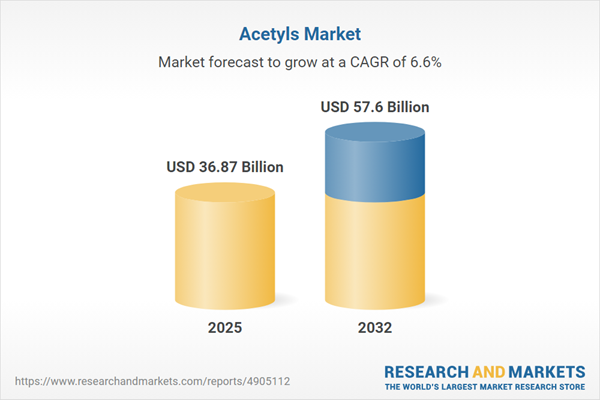Speak directly to the analyst to clarify any post sales queries you may have.
Acetyl derivatives play an essential role across industrial value chains, supporting transformation throughout chemicals, pharmaceuticals, coatings, and broad consumer sectors. For senior decision-makers, the acetyls market presents ongoing opportunity and evolving challenges as innovation, regulation, and supply chain strategies reshape competitive priorities.
Market Snapshot: Acetyls Market Size and Growth Overview
The global acetyls market is experiencing steady expansion, with market value advancing from USD 34.61 billion in 2024 to USD 36.87 billion in 2025 and projected to reach USD 57.60 billion by 2032 at a compound annual growth rate of 6.57%. This growth is underpinned by persistent industrial demand, increased adoption of sustainability-driven solutions, and a strong shift toward bio-based intermediates. Market momentum is observed in both mature and developing economies, where diversification within downstream categories helps maintain relevance and fuel progress in both regional and international segments.
Scope & Segmentation of the Acetyl Derivatives Market
- Product Types: Includes key acetyl compounds such as acetic anhydride, acetyl chloride, butyl acetate, ethyl acetate, methyl acetate, and vinyl acetate monomer, each tailored to different end-use requirements.
- Applications: Spanning adhesives and sealants used in construction, packaging, and woodworking; coatings for decorative and industrial purposes; pharmaceutical intermediates in drug formulation; ingredients in printing inks; and enhancement of both natural and synthetic fibers in textiles.
- Purity Grades: Acetyl derivatives are segmented by grade—food, industrial, and pharmaceutical—to suit distinct regulatory and application needs.
- Regions Covered: Extensive global coverage includes the Americas (United States, Canada, Mexico, Brazil, Argentina, Chile, Colombia, Peru); Europe, Middle East & Africa (e.g., United Kingdom, Germany, France, Russia, Italy, Spain, Netherlands, Sweden, Poland, Switzerland, United Arab Emirates, Saudi Arabia, Qatar, Turkey, Israel, South Africa, Nigeria, Egypt, Kenya); Asia-Pacific (e.g., China, India, Japan, Australia, South Korea, Indonesia, Thailand, Malaysia, Singapore, Taiwan).
- Technology Focus: Innovations include process intensification, digital manufacturing, bio-based feedstocks, catalytic conversion, solvent recovery, membrane separation, and the use of advanced analytics. These advancements support operational efficiency, reduce emissions, and align with evolving regulatory standards.
- Companies Profiled: The competitive landscape features Celanese Corporation, Eastman Chemical Company, LyondellBasell Industries N.V., Mitsubishi Chemical Corporation, Saudi Basic Industries Corporation, BP p.l.c., INEOS Group Holdings S.A., Sasol Limited, Formosa Plastics Corporation, and Sinopec Limited.
Key Takeaways for Senior Decision-Makers
- Supply chain agility is an emerging competitive advantage, driving focus on diversification of sourcing and strategic inventory management to address volatility.
- Sustainability, particularly through adoption of bio-based feedstocks and commitment to green chemistry, is increasingly a market differentiator as customers and regulators raise expectations.
- Technological integration is gathering pace, with investments in digital twins, process automation, and analytics supporting operational optimization and consistent product quality.
- Industry alliances and targeted acquisitions are accelerating the co-development of customized acetyl solutions, fostering innovation and adapting to shifting customer demands.
- Granular segmentation by product, application, and grade enables tailored strategies, allowing companies to identify high-value opportunities and refine market approaches.
Tariff Impact: Navigating Trade Policy Headwinds
Recent tariffs imposed by the United States on acetyl derivatives have significantly influenced global cost structures and sourcing models. As a result, organizations are reconsidering production geography and exploring new supplier relationships to safeguard operating margins. Approaches such as bolstering domestic production capabilities, optimizing logistics contracts, and implementing flexible inventory models have become prominent, emphasizing the importance of coordinated scenario planning and strengthened cross-functional engagement.
Methodology & Data Sources
The report relies on primary research methods, including direct interviews with executives and technical experts, in-person data verification, and integration of proprietary industry databases. Secondary sources include company records, regulatory documents, conference materials, and expert commentary, ensuring comprehensive and actionable insights.
Why This Report Matters for the Acetyls Market
- Enables focused strategy development by clarifying the trends, drivers, and segment dynamics influencing market performance.
- Equips leadership to address compliance and innovation priorities through comparative sustainability benchmarks and digital transformation insights.
- Assists in effective allocation of resources by mapping the evolving landscape of competition and supply chain strategy.
Conclusion
Proactive management of risk, agility in navigating regulations, and sustained innovation will be fundamental for stakeholders to strengthen their positioning and realize growth across the acetyl derivatives market's diverse segments and global regions.
Additional Product Information:
- Purchase of this report includes 1 year online access with quarterly updates.
- This report can be updated on request. Please contact our Customer Experience team using the Ask a Question widget on our website.
Table of Contents
3. Executive Summary
4. Market Overview
7. Cumulative Impact of Artificial Intelligence 2025
List of Figures
Samples

LOADING...
Companies Mentioned
The key companies profiled in this Acetyls market report include:- Celanese Corporation
- Eastman Chemical Company
- LyondellBasell Industries N.V.
- Mitsubishi Chemical Corporation
- Saudi Basic Industries Corporation
- BP p.l.c.
- INEOS Group Holdings S.A.
- Sasol Limited
- Formosa Plastics Corporation
- Sinopec Limited
Table Information
| Report Attribute | Details |
|---|---|
| No. of Pages | 199 |
| Published | October 2025 |
| Forecast Period | 2025 - 2032 |
| Estimated Market Value ( USD | $ 36.87 Billion |
| Forecasted Market Value ( USD | $ 57.6 Billion |
| Compound Annual Growth Rate | 6.5% |
| Regions Covered | Global |
| No. of Companies Mentioned | 11 |









